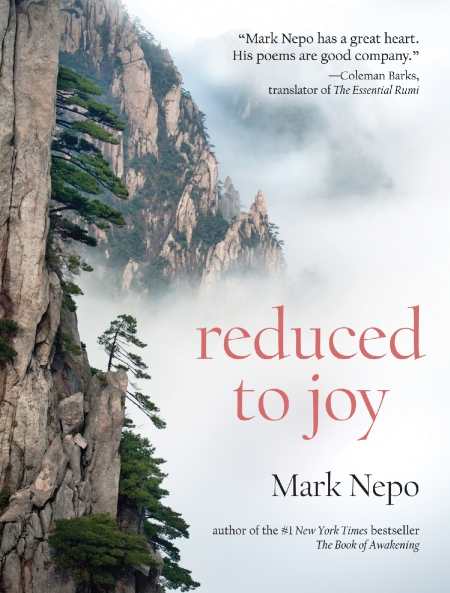Reduced to Joy
Mark Nepo’s latest poetry collection is about softening the heart, letting go, while also embracing the whole human experience.
Known for his inspirational perspectives on the common principles found across all religious traditions, best-selling author Mark Nepo writes at the intersection of poetry, philosophy, health, and spirituality. His aptly named seventh book of poems plays with the idea that joy is what we’re reduced to—rather than something we ascend to—possibly after a loss of some kind. Therefore, the route of many poems in Reduced to Joy is toward the earth, falling from height, humbled rather than self-satisfied with an upwardly mobile course.
Nepo’s regular readers will recognize his commitment to self-inquiry and curiosity about the nature of being and existence, as well as his observations on the sacredness of everyday life. Nepo was diagnosed with a rare form of lymphoma in 1987 and his work is clearly derived from his journey as a cancer survivor who has done a lot of thinking about life and death.
Nepo writes about daily life, a decades-old heartbreak, the death of a beloved pet, and his father who only very late in life has slowed down to the point of wondering what his son does, thus giving rise to a rare connection in which they talk about wood and tools: “After years of silence, / it’s more than enough.”
Throughout, Nepo employs the philosopher’s knack for questions in an effort to pry open the unknown, too: “There are buds / on the maple though it is October. / Even wet concrete seems beautiful. / If I knew the question, I’d ask it / of everyone.”
These poems feel utterly of this moment when they make reference to business meetings, air travel, and managing incoming e-mails, though the influence of the Sufi poet Rumi is felt here as well. Nepo is a modern, public figure, but with the heart of an ecstatic, and this brimming enthusiasm may account for the presence of a few too many turns of phrase that call to mind the genre of inspirational literature.
Some selections feel overwritten and the book could use more selective curation, while one of the best poems appears late in the book and seems to benefit from the fact that so much has already been said so that now he can speak simply, in pure images. The poem is a list of actions, all of which afford the speaker some kind of closeness, for example: “Putting / a child on a horse.” and “Watching / snow fill the crack / in a bridge.” but also “Letting / the stone / in your heart crumble.”
If this collection is “about” anything, and poets generally resist this kind of summation, it may be that last image: softening the heart, letting go, while also embracing the whole human experience.
Reviewed by
Holly Wren Spaulding
Disclosure: This article is not an endorsement, but a review. The publisher of this book provided free copies of the book and paid a small fee to have their book reviewed by a professional reviewer. Foreword Reviews and Clarion Reviews make no guarantee that the publisher will receive a positive review. Foreword Magazine, Inc. is disclosing this in accordance with the Federal Trade Commission’s 16 CFR, Part 255.

